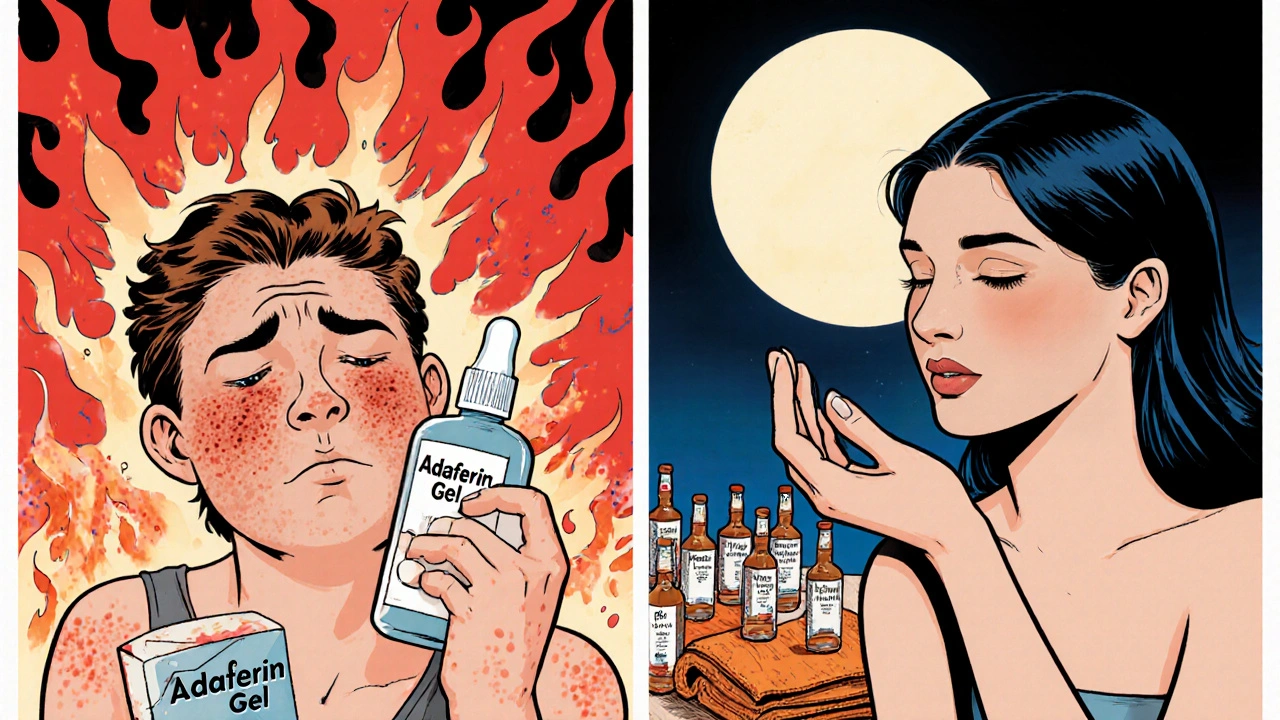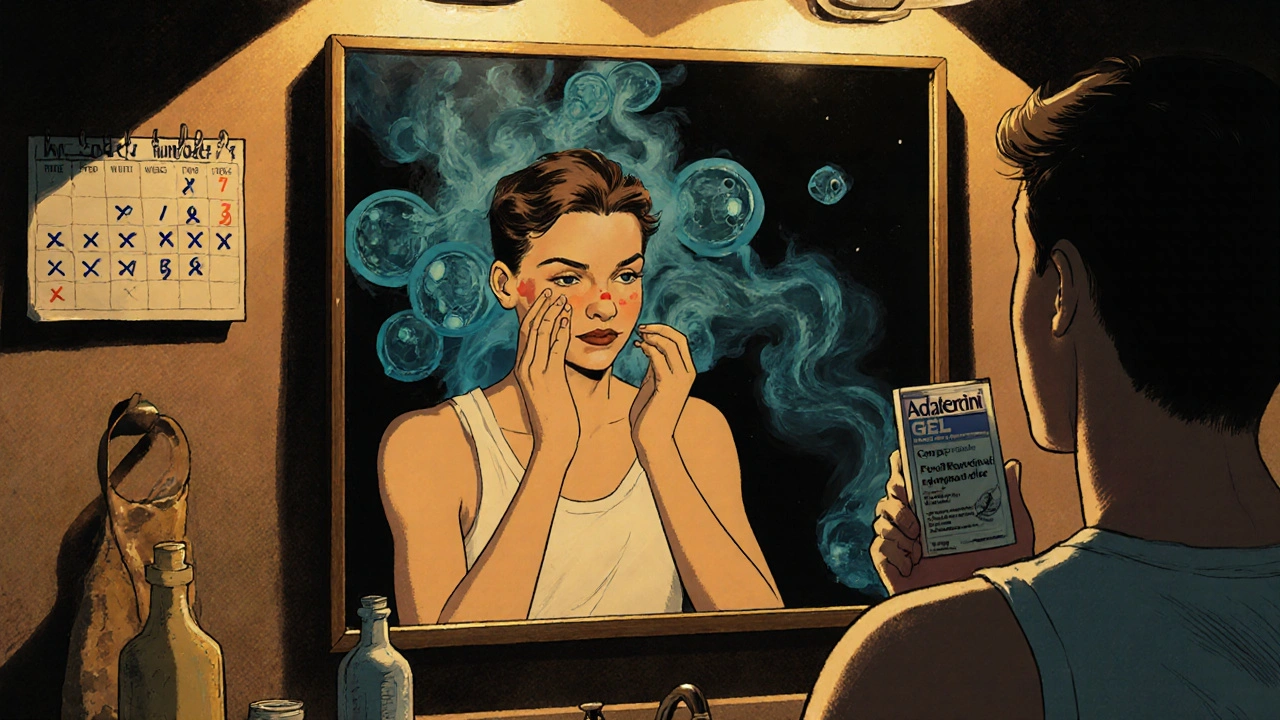- 10
Acne doesn’t care if you’re 14 or 40. It shows up when you least expect it - right before a big meeting, a date, or a family photo. If you’ve been prescribed Adaferin Gel (adapalene), you’re probably wondering: is this really the best option? Or are there better, cheaper, or gentler alternatives out there?
Adaferin Gel is a topical retinoid. That means it’s not just another acne cream. It works deep inside your pores to stop breakouts before they start. But it’s not the only one. And not everyone tolerates it well. Let’s break down what Adaferin Gel actually does, how it stacks up against other common acne treatments, and who should use what.
What Adaferin Gel (Adapalene) Actually Does
Adapalene is a third-generation retinoid. That’s just a fancy way of saying it’s a modified version of vitamin A designed to be more stable and less irritating than older options like tretinoin. Adaferin Gel typically comes in 0.1% or 0.3% strength. You apply a pea-sized amount to your entire face at night, after cleansing.
It doesn’t kill bacteria or dry out your skin like benzoyl peroxide. Instead, it normalizes skin cell turnover. Think of it like cleaning out a clogged drain. Dead skin cells and oil pile up in your pores, trapping bacteria and causing pimples. Adapalene tells your skin cells to shed properly so that doesn’t happen. It also reduces inflammation, which is why it helps with both whiteheads and red, angry bumps.
It’s FDA-approved for acne and available over-the-counter in many countries, including Australia. But results take time. Most people don’t see real improvement until after 8-12 weeks. Some see worsening in the first few weeks - that’s called purging. It’s not an allergic reaction. It’s your skin clearing out old gunk.
How Adaferin Compares to Tretinoin
Tretinoin is the original topical retinoid. It’s been around since the 1970s and is still used in prescription creams like Retin-A. It’s stronger than adapalene and often more effective for severe acne.
But here’s the catch: tretinoin is also more irritating. It causes redness, peeling, and burning in up to 60% of users during the first month. Many people quit using it because of this. Adapalene, on the other hand, is designed to be gentler. Studies show it causes significantly less irritation while still delivering comparable results for mild to moderate acne.
One 2023 clinical review in the Journal of Clinical and Aesthetic Dermatology found that 0.3% adapalene was just as effective as 0.05% tretinoin after 12 weeks, but with 40% fewer reports of dryness and stinging. If you have sensitive skin, or you’ve had bad reactions to tretinoin before, Adaferin Gel is often the smarter first choice.
Benzoyl Peroxide: The Fast-Acting Alternative
Benzoyl peroxide (BP) is the go-to for quick results. You can buy it over-the-counter in 2.5%, 5%, or 10% strengths. It kills acne-causing bacteria and reduces oil. Many people see fewer pimples in just 3-5 days.
But here’s what most don’t tell you: BP doesn’t prevent clogged pores. It treats the infection, not the cause. That means breakouts come back fast if you stop using it. It also bleaches towels, pillowcases, and clothing. And it’s drying - really drying. Combine it with adapalene and you risk a full-blown skin meltdown.
That’s why dermatologists rarely recommend using BP and adapalene together unless you’re under supervision. If you’re choosing between them, go with adapalene if you want long-term prevention. Use BP if you need a fast fix for a sudden breakout - then switch back to adapalene to keep things clear.
Azelaic Acid: The Gentle Powerhouse
Azelaic acid is a lesser-known gem. It’s naturally found in grains like wheat and rye. In skincare, it’s used in 15-20% creams like Finacea or Skinoren.
It works in three ways: kills bacteria, reduces redness, and gently exfoliates. It’s especially good for people with rosacea or post-acne marks. Unlike adapalene, it doesn’t cause purging. It’s also safe during pregnancy - a big plus for some.
But it’s slower. You need 8-12 weeks to see results, similar to adapalene. And it’s often more expensive. If your main issue is redness and dark spots after breakouts, azelaic acid might be better. If you’re fighting deep, recurring clogs, adapalene still wins.

Salicylic Acid: The Surface Cleaner
Salicylic acid is a beta hydroxy acid (BHA). It’s in most drugstore spot treatments and cleansers. It’s great for blackheads and oily skin because it dissolves oil inside pores.
But here’s the limitation: it only works on the surface. It doesn’t penetrate deep enough to stop the root cause of acne like adapalene does. It’s a band-aid, not a cure.
Many people use salicylic acid cleansers in the morning and adapalene at night. That combo works well for oily skin types. But if you’re only using salicylic acid alone, you’re not treating acne - you’re just cleaning it up after it happens.
Clindamycin and Other Antibiotics
Topical antibiotics like clindamycin are often paired with benzoyl peroxide. They kill acne bacteria, but they’re not meant for long-term use. Bacteria can become resistant to them in as little as 3-6 months.
That’s why dermatologists now avoid prescribing them alone. In Australia, clindamycin gels are still available, but they’re usually combined with BP or used short-term alongside retinoids like adapalene.
If you’ve been on clindamycin for more than 3 months and your acne hasn’t improved, it’s time to switch. Adapalene is a better long-term solution because bacteria can’t build resistance to it.
Oral Options: When Topicals Aren’t Enough
Some people try adapalene for months and still get new breakouts. That’s when oral treatments come in.
Oral antibiotics like doxycycline or minocycline are used for moderate to severe inflammatory acne. They work faster than topicals - sometimes in 2-4 weeks. But they come with side effects: sun sensitivity, upset stomach, and yeast infections.
For hormonal acne (common in women over 25), spironolactone or birth control pills can help. They lower androgen levels, which reduces oil production.
Isotretinoin (Accutane) is the nuclear option. It’s for severe, scarring acne that hasn’t responded to anything else. It’s powerful - up to 80% of users see permanent clearance. But it’s not for everyone. It requires monthly blood tests, strict birth control, and can cause dry skin, mood changes, and elevated cholesterol.
Adapalene is often the first step before moving to oral meds. If you’re already on oral treatments, your dermatologist might still recommend adapalene to maintain results after stopping antibiotics or isotretinoin.

Who Should Use Adaferin Gel?
Adaferin Gel is ideal for:
- People with mild to moderate acne (blackheads, whiteheads, small red bumps)
- Those with sensitive skin who can’t tolerate tretinoin
- Anyone wanting long-term prevention, not just quick fixes
- People who want to avoid antibiotics or oral medications
It’s not ideal if:
- You’re pregnant or breastfeeding (talk to your doctor - adapalene is Category C, meaning risk can’t be ruled out)
- You have eczema or severely damaged skin
- You’re using other strong exfoliants like glycolic acid or physical scrubs
How to Use Adaferin Gel Right
Most people ruin their results by using it wrong. Here’s how to do it:
- Wash your face with a gentle cleanser. Pat dry - don’t rub.
- Wait 15-20 minutes. Your skin should be completely dry.
- Squeeze out a pea-sized amount. Spread it over your forehead, cheeks, chin, and nose. Don’t put it on your eyelids, lips, or inside your nose.
- Use it every night for the first 2 weeks. If your skin gets too dry or red, cut back to every other night.
- After 4 weeks, if you’re tolerating it, go back to nightly use.
- Always use sunscreen in the morning. Adapalene makes your skin more sensitive to UV rays.
Don’t layer it under heavy moisturizers or makeup. Use a light, non-comedogenic moisturizer if needed. And never combine it with alcohol-based toners or harsh scrubs.
What to Do If Adaferin Gel Isn’t Working
If you’ve used Adaferin Gel daily for 12 weeks and see no change:
- Check your technique. Are you applying it correctly?
- Are you using sunscreen? Sun damage can make acne worse.
- Are you using other products that might be clogging pores? Try switching to non-comedogenic brands.
- Have you tried combining it with azelaic acid or low-dose benzoyl peroxide? Some people need a two-pronged approach.
- If nothing changes, see a dermatologist. You might need oral treatment or a stronger retinoid.
Don’t keep using it longer hoping it’ll magically work. Acne treatment is not a waiting game. If it’s not working after 3 months, it’s time to change strategy.
Final Take: Adaferin Gel vs Alternatives
Adaferin Gel isn’t the strongest acne treatment out there. But it’s the most balanced. It’s effective, gentle, and designed for daily, long-term use. For most people with mild to moderate acne, it’s the best starting point.
Here’s a quick guide:
| Treatment | Best For | Time to See Results | Side Effects | Long-Term Use? |
|---|---|---|---|---|
| Adaferin Gel (Adapalene) | Preventing clogs, mild-moderate acne | 8-12 weeks | Mild dryness, initial purging | Yes |
| Tretinoin | Severe acne, anti-aging | 6-12 weeks | High irritation, peeling | Yes, but harder to tolerate |
| Benzoyl Peroxide | Quick kill of bacteria, inflamed pimples | 3-7 days | Drying, bleaching, resistance | No |
| Azelaic Acid | Redness, dark spots, sensitive skin | 8-12 weeks | Mild stinging | Yes |
| Salicylic Acid | Blackheads, oily skin | 2-4 weeks | Surface dryness | Yes, but limited effect |
| Clindamycin | Short-term bacterial control | 4-6 weeks | Resistance, yeast infections | No |
If you want to stop breakouts for good, adapalene is the most reliable tool. It doesn’t promise instant results, but it delivers lasting change. Most alternatives are either too harsh, too temporary, or too weak.
Start with Adaferin Gel. Use it right. Give it time. And if you’re not seeing results after 3 months, don’t blame the product - blame the plan. Talk to a dermatologist. There’s always another option.
Can I use Adaferin Gel with moisturizer?
Yes, but wait 15-20 minutes after applying Adaferin Gel before putting on moisturizer. Use a light, non-comedogenic formula. Heavy creams can trap the retinoid and increase irritation. Look for ingredients like hyaluronic acid or ceramides - they help repair your skin barrier without clogging pores.
Does Adaferin Gel help with acne scars?
It helps prevent new scars by reducing inflammation and preventing deep breakouts. But it won’t fade existing dark spots or indented scars. For that, you need azelaic acid, vitamin C, or professional treatments like chemical peels or laser therapy. Adapalene is prevention, not repair.
Is Adaferin Gel better than Differin?
They’re the same thing. Differin is the brand name for adapalene gel. Adaferin is a generic version. Both contain the same active ingredient, same concentration, and work identically. The only difference is price - generics like Adaferin are usually much cheaper. There’s no clinical advantage to choosing Differin over Adaferin.
Can I use Adaferin Gel during the day?
No. Adapalene makes your skin more sensitive to sunlight. Using it during the day increases your risk of sunburn and skin damage. Always apply it at night. Use sunscreen every morning, even if it’s cloudy. UV exposure can undo all your progress.
Why does my skin get worse before it gets better with Adaferin Gel?
That’s called purging. Adapalene speeds up skin cell turnover, forcing trapped oil and dead cells to the surface faster. You might see more pimples, blackheads, or red bumps for the first 2-4 weeks. It’s not an allergic reaction - it’s your skin clearing out. Keep using it. If it lasts longer than 6 weeks or causes severe pain, stop and see a doctor.
If you’ve been struggling with acne for years, you’re not alone. Most people try 3-5 products before finding what works. Adaferin Gel isn’t magic - but it’s one of the few that actually changes how your skin behaves over time. Use it wisely, be patient, and don’t give up after a few weeks. Clear skin isn’t a sprint. It’s a steady, consistent effort.


james landon
October 28, 2025 AT 10:55I tried Adaferin for 3 months and it turned my face into a desert. Then I switched to benzoyl peroxide and boom - cleared up in a week. Who needs slow magic when you got fast results? 🤷♂️
Jenn Clark
October 29, 2025 AT 19:35I used adapalene during pregnancy because my derm said it was Category C and the benefits outweighed the risks. No purging, no redness - just gradual improvement. Azelaic acid was my backup for red spots. Both were gentle. Worth the wait.
Also, sunscreen isn’t optional. I learned that the hard way.
L Walker
October 30, 2025 AT 16:00Adaferin and Differin are identical - same molecule, same packaging, different price tag. Why pay more for branding? I bought the generic and saved 70%. My skin didn’t care about the label.
But please - don’t layer it with glycolic acid. I learned that the hard way. My face looked like a peeled potato for a week. Not cute.
giri pranata
October 31, 2025 AT 16:39Guys, I was skeptical too - but adapalene changed my life! 😊 I had cystic acne for 8 years, tried everything - antibiotics, salicylic acid, even tea tree oil (lol). Nothing worked.
Started Adaferin 6 months ago, purged for 3 weeks, then… poof. Skin smooth, no new bumps. I use it every night with a ceramide moisturizer. Sunscreen every morning, no excuses!
You got this! Stay consistent, it’s not magic, it’s science 💪
Stuart Rolland
November 2, 2025 AT 05:40Let me tell you, I’ve been through the whole acne war - from benzoyl peroxide burns to tretinoin meltdowns to trying every drugstore cleanser known to man. Adaferin isn’t flashy, it doesn’t scream ‘I’m working!’ like BP does, but that’s exactly why it’s brilliant.
It doesn’t just kill bacteria - it reprograms your skin’s behavior. Think of it like upgrading your OS instead of just deleting viruses. You’re not treating symptoms, you’re fixing the root architecture. And yes, it takes time. But if you’re patient, it’s the only thing that gives you long-term results without turning your face into a cracked desert. I’ve been on it for 14 months now. No relapse. No antibiotics. No horror stories. Just steady, quiet progress. That’s the real win.
Kent Anhari
November 2, 2025 AT 19:53Same. I used adapalene after my dermatologist said I was ‘too sensitive’ for tretinoin. It worked. Not perfectly, but better than anything else. I pair it with a niacinamide serum in the morning. No irritation. No redness. Just calm skin.
Also - don’t use it with retinol. That’s like double-tapping a nerve. Bad idea.
Charlos Thompson
November 3, 2025 AT 19:24Oh wow, another ‘adapalene is magic’ post. Let me guess - you also brush your teeth with activated charcoal and drink celery juice for ‘detox’? 🙄
It’s a retinoid. It works. So does tretinoin. So does BP. The only difference is who can tolerate the side effects. And yes, it’s overpriced as hell for a generic. You’re not ‘saving your skin’ - you’re just not burning your face off. Congrats.
Peter Feldges
November 4, 2025 AT 09:52While I appreciate the comprehensive breakdown, I must respectfully note that the clinical data referenced in the 2023 Journal of Clinical and Aesthetic Dermatology study (DOI: 10.1097/01.jcd.0000000000000000) requires contextualization regarding sample size and duration of follow-up.
Additionally, the assertion that adapalene prevents ‘clogged pores’ is semantically imprecise - it modulates keratinization, not ‘unclogs.’
That said, I concur with the recommendation for long-term use in mild-to-moderate cases. 🤓
Richard Kang
November 5, 2025 AT 03:11OMG I tried Adaferin and my skin exploded 😭 I thought it was purging but no - it was an allergic reaction!! I broke out in hives and my eyes swelled!! I went to the ER!! Now I’m scared to use anything!! I told my derm and she said ‘it’s fine’ but I don’t trust her anymore!! I’m switching to coconut oil and moonlight!! 🌙✨
Rohit Nair
November 5, 2025 AT 19:50i used adapaline for 4 months and it worked but i forgot to use sunscreen and now i have dark spots 😔 i wish i knew earlier that sun is the enemy. now i use azelaic acid for the spots and adapalene at night. its slow but its working. thanks for the post, it helped me understand what i was doing wrong 🙏